The Native peoples of the Great Plains consist of a variety of cultures who adopted a similar lifestyle that enabled them to survive in this relatively harsh region. These peoples based their subsistence upon the great bison herds, depending on them for food, clothing, and shelter; following these herds required the Great Plains peoples to adopt a nomadic existence with few material possessions. Artistic expression was therefore incorporated into practical items, including everyday clothing, lodging, tools, and weapons. Each Great Plains culture has cultivated individualized designs and color schemes that can be identifiable, but extensive interaction and trade have also resulted in combined patterns and colors, making some items difficult to attribute to a specific cultural group.
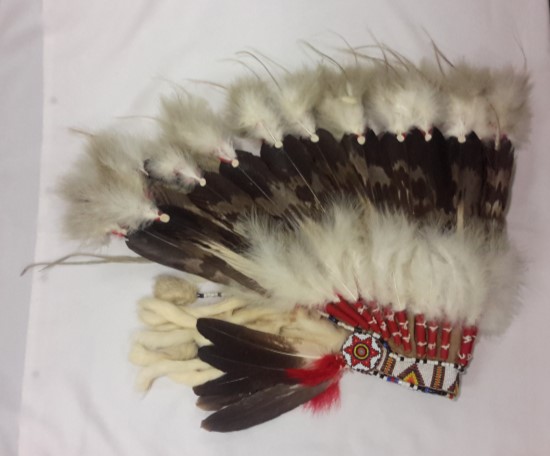
Crow culture
ca. 19th century
Feathers, glass beads, fur, and leather, L. 69 cm x W. 52 cm x H. 15 cm
Ralph Foster Museum collection #NN001
Headdresses are used to show status, and they are worn as part of regalia for dances, pow-wows, and other gatherings. This headdress was likely made by an artisan of the Crow nation, as it is relatively simply decorated with a strip of beadwork and two rosettes, and it does not have a long train of feathers. The large feathers in the headdress are highly symbolic; in the past, feathers were gifted or awarded to a person and usually represented the number of battles that a soldier had fought. Today, feathers are still gifted and awarded, but they may represent a variety of honors, such as an office held. Researched by Macaylah Gant Hodge
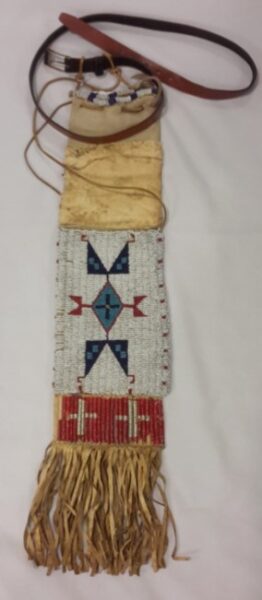
Lakota Sioux culture
ca. 19th century
Leather, porcupine quills, pigments, and glass beads, L. 15 cm x W. 1 cm x H. 63 cm
Ralph Foster Museum collection #82.038.27
Because tobacco does not grow well in the Great Plains region, tobacco was a luxury item for these cultures, and elaborately decorated tobacco bags were used to carry tobacco and one or more smoking pipes. Tobacco bags range in size from the very small “spit bag,” which held a small amount of chewing tobacco and could be carried in a pocket, to large bags that could carry as much as five pounds of tobacco. People seeking spiritual power, protection, or a positive outcome to a difficult situation would offer tobacco and the smoke from their pipes to the Sacred Powers, their equivalent of a deity. Oaths and pacts of friendship might also be sealed through sharing a smoking pipe. Researched by Macaylah Gant Hodge
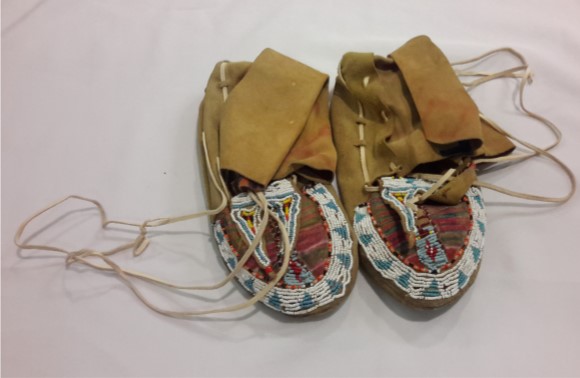
Great Plains cultures, including Lakota Sioux and Comanche
ca. 20th century
Leather, glass beads, and pigment, L. 30 cm x W. 12 cm x H. 4 cm
Ralph Foster Museum collection #NN002
Moccasins are the leather footwear that was widely produced and worn by Native Americans, but each nation tended to cut, sew, and decorate their moccasins differently; interaction and the trade of ideas within each region, however, can blur these finer distinctions. Like those produced by Great Plains nations, these moccasins are made out of one piece of leather and have soft soles–and the wear on the soles indicates that they experienced considerable use. The colors of the beadwork suggest that the moccasins might be Lakota Sioux, but the cut and shape of the moccasins, along with the beadwork pattern, suggest that they might be Comanche. The painted designs (which may have been made using markers), however, appear to be unique to the person who owned these moccasins, as they show no clear cultural affiliation. Researched by Macaylah Gant Hodge
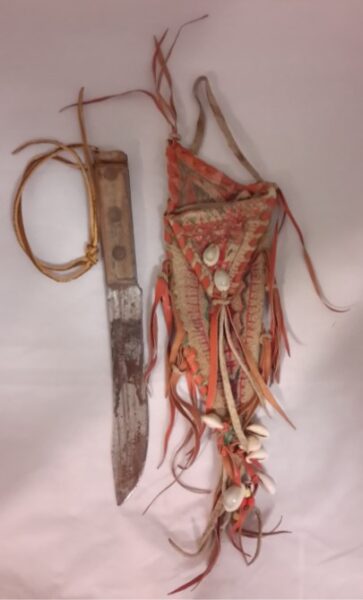
Great Plains cultures, including Lakota Sioux and Cheyenne
ca. 19th century
Leather, wood, steel, cowrie shells, and pigment,
L. 11 cm x W. 4 cm x H. 45 cm
Ralph Foster Museum collection #NN006
Among all cultures, knives have been used for a variety of purposes, from cutting and gathering plants to skinning animals. In times past, knives were also used as primary eating utensils and in rituals, while today they are used more commonly in the preparation of food. While the size of the knife blade varied, the shape was what generally determined the role and purpose of a knife. The knife in this display is simple and utilitarian, with a steel blade and a wooden handle; however, the sheath is well-decorated with geometric designs, fringe, and cowrie shells. The geometric designs have likely been drawn onto the sheath with marker, and they appear to follow the individual aesthetic preferences of the owner. As cowrie shells are found in the ocean waters, these would have been long-distance trade items; because of their size, shape, white color, and shiny surface, cowrie shells are often substituted for elk’s teeth, an ornament that was highly desirable, particularly among the Lakota Sioux and Cheyenne nations. Researched by Macaylah Gant Hodge
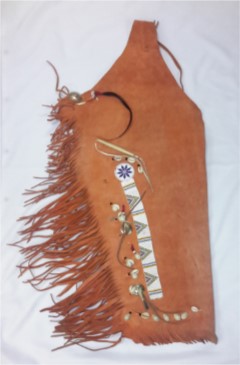
Comanche culture
ca. 19th century
Leather, cowrie shells, and glass beads, L. 48 cm x W. 1 cm x H. 48 cm
Ralph Foster Museum collection #NN004
Leggings are tube-shaped, individual pant legs that are each made of one piece of leather that was cut, folded over, and sewn, and they were not connected together in the center. Leggings are often worn for protection when horseback riding, hunting, or performing other physical activities that require leg protection. These are identifiable as men’s leggings because they are large, long, and they would cover the legs from the thigh to the ankle; women’s leggings, in contrast, cover the legs only from thigh to knee, as this was the area not covered by a woman’s tall boots. The placement of the seam on these leggings, and the beaded strip with triangular lodge or mountain designs, suggest that these leggings were made by a Cheyenne artisan. Researched by Macaylah Gant Hodge
For more information, you may contact the researcher(s) noted in the title of this exhibit entry, or Dr. Billie Follensbee, the professor of the course, at BillieFollensbee@MissouriState.edu
